 This a report of the cruise taken by myself and my wife. We've taken other cruises before but I haven't extensively blogged them.
This a report of the cruise taken by myself and my wife. We've taken other cruises before but I haven't extensively blogged them.For what its worth this is only one of my blogs. I have others.
For example, our Weiss family chronicles, and our Weiss family summary.
Our travel agent for this cruise was:
CallYourTravelAgent
 Before the Baltic Cruise- August 13
Before the Baltic Cruise- August 13We left Dulles Airport on Aug 12 and arrived in the early am of Aug 13 at the Airport that serves Amsterdam.
This airport is below sea level (by about 8-16 feet or so). Thus the flight navigation channel is a bit fun to read as you are descending. The airport has art showing ice cream and cows but nothing about the red light district.
The cruise line sent people to meet us at the airport.
We had about 5 hours before boarding time on the ship so we took a bit of a tour.
One site was the cheese and shoe factory. I learned that the reason Dutch people wore wooden shoes (Klompen ) was that it was wet in the fields (the water table being very high) and that was the best waterproofing they had in the 13th century when they started cultivating the area (or so the guy at the shop said).

Another thing we saw on this mini tour was Rembrandt Park which is not too far from downtown. It is not historically connected with the painter, they just thought he should have a park.
The fellow in bronze is Rembrandt. Besides a windmill, there is also a petting zoo and a canal and some landscaping.

The Century (Celebrity Line)
The ship we boarded was the Century which is owned by the Celebrity Line (which is a partner of the Royal Caribbean Line).
It is about 800 feet long and weighs about 71,000 tons (or 140,000,000 pounds). It has 12 decks (although only the crew can access some of it) and if you stand on the 12th deck (or sit, because there is a nice lounge there), you will be about 100-140 feet above the water.
We had some nice people to share our suppers with (most evenings we had assigned seating at supper - some evenings with late arriving shore excursions were open seating). There were three people from Boston, two from Paris, two from England and two from Ireland (and us). By chance, we saw the Englanders and the Irish in Amsterdam.
The draft of the Century is about 25 feet and it can cruise at 22 knots. It probably had about 900 crew plus 1500-2000 guests) during our cruise.
Monday, August 17, 2009

 Stockholm -
Stockholm -Harbor
and
Royal Palace
We were at sea on Aug 14 and docked near Rostock, Gemany on Aug 15 and I have no images from there.
The first three images are from one of the islands overlooking the Stockholm Harbor.
The first image of the harbor shows (in the center) an island which was once a military fort. On the right is an amusement park.
The second image of the harbor shows Ann overlooking a road which serves the harbor. In the background is the 'old town' (or gamla stan in Swedish.)
The old town was started in the 13th century or so. It is the site of the Royal Palace and other important buildings.

 The third image shows some large cruise ships (but not as large as ours) docked in the harbor.
The third image shows some large cruise ships (but not as large as ours) docked in the harbor.
The last two images are of the Royal Palace.
The Royal Palace in Stockholm has one fewer room than the Royal Palace in London. It was built from about 1730 to 1820 on the site of several other palaces that either burned or were damaged or had become too small.
Currently Carl Gustave XVI has his official residence there.
The gold embossed lettering says that it was dedicated to Carl XII (aka Charles XII) of Sweden, who was the last great King of the Swedish empire (which, despite winning most of the battles, ultimately took a beating in the Northern War of the early 1700s).
Actually, Charles XII was probably only the 6th real Charles of Sweden to rule but they also counted legendary rulers.
Stockholm City Hall is Next
.
.
.

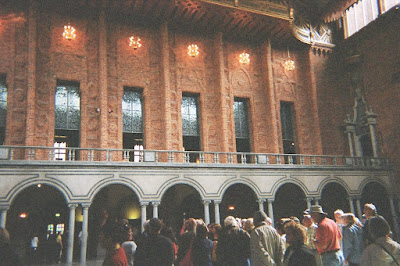
The city hall (Stockholms stadshus or Stadshuset ) is a palace of sorts and was built in the early part of the 20th century (dedicated in 1920).
I thought the most impressive part of this place was the Gold Room (the whole room image is commercial, the other images , except the one of the hall from the outside were what I took myself). This room is about 40' high, 100' long and 60' wide and the entire room is covered with tiles (wikipedia says about 18 million tiles). Most of the tiles are gold plated. Some are plated with colors to make desig

 n
n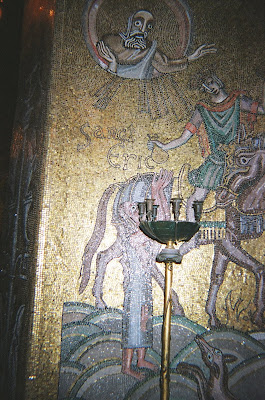
One such design is of St Eric who is a 12 century clergyman who, although never cannonized by the Catholic Church, spread Christianity in Sweden. In the last part of his career he made rounds of various noblemen telling them about the value of tithing to the church. Apparently, this didn't set well with some of the nobility who had him beheaded. That's why the image looks poorly done. All images of St Eric are done this way in Sweden.

One fairly unique part of the design of this building is that an interior atrium that is designed to look as if it is outside (but it is not outside). This apparently was done to allow the Swedes to enjoy a rain free outside type experience on the inside.
This atrium has a ceiling about 80' high and the courtyard can hold several thousand.
In the anteroom to the legislative chamber is, among other things, a carving done in an earlier century (I think the 17th) which was in a previous building on this site.
The characters on the carving are evil spirits that have been tamed (or something similar to this)
The outside of City Hall has a high (about 350') tower which serves no use except that it is iconic.
Tuesday, August 18, 2009
Helsinki




The first image is that of the Helsinki Rock Church or Temple of Rock which in Finnish is Temppeliaukio Kirkko. It was completed in 1969 by building into a stone hill. It is very popular for marriages. We were told that if you want to have a marriage here on a Sunday in the summer, you have to book it 2 years in advance, which, per our tour guide, means people book the church first and then find someone to marry.
The second and third images are made in Senate Square. The Russians established the Senate Square during their rule of Finland. During this time (about 1810 to 1917), Finland was called the Grand Duchy of Finland. The square is called Senaatintori in Finnish and Senatstorget in Swedish. Almost every street in Helsinki has a Finnish and Swedish name (Finland was part of Sweden for several hundred years). The architect of the square was a German working for Alexander I. Scenes from Warren Beatty's movie "Reds" were shot here. The statute is of Alexander II (the good Czar) who allowed a large degree of self rule for Sweden. During the reign of Nicholas II, people put flowers on the statute as a type of protest. The Church was formerly called the Church of Nicholas but now is called the Helsinki Cathedral (and is Lutheran). The Russian Govt. was disliked enough by the ethnic Russians that many Russian Orthodox churchs became Greek Orthodox after 1917.
The small building is at an outdoor park. It shows what life was like for Finlanders once upon a time. The park itself is a 80+ acre place.
Our guide made the following comment. "Our taxes are very, very high; as much as 75% for people who have very high earnings. But this makes our crime rate low because people say, 'why steal when the government does it for you.'"
Wednesday August 19
Summer Palace in Puskin, Russia
 This is also known as the Catharine Palace.
This is also known as the Catharine Palace.

The most famous item in the palace is the amber room. I got this image (left) off the internet - you aren't allowed to photograph this room on tours. The room was created in the 1800s. The walls and furniture were completely covered with amber (room is about 15 feet high and 30' by 30'). The Nazis stole the amber and its current location is a mystery.
Regarding the palace itself, in the early 18th century the Czars had their summer palace ( Tsarskoye Selo) in a town a bit east and north of St Petersburg.
It was called Pushkin (Пу́шкин in Russian) in 1937 by the Soviets. Other than the various court officials, there was another famous person in the town. His name was Alexander Sergeyevich Pushkin and in the center is his statue. He is famous for many works including the play Boris Godunov which was the basis for the opera by Modest Mussorgsky. His daughter Maria is said to be the prototype for Tolstoy's Anna Karenina (correction to original version due to S. Natzke).
This part of Russia was occupied by the Nazis for several years in WWII. Much was stolen. The building was, however, left alone and has mostly been restored. The third image is the front of the summer palace. The decorative features are gilded.


The fourth image is the gate leading to the summer palace.

 The decorative features are gold or gold plating.
The decorative features are gold or gold plating.The gilding done in the summer palace mostly uses the technique of creating a gold paint and applying the paint as normal and then using heat to melt the gold particles to the base.
The fifth image is the ballroom at the summer palace. Mostly gilding is used on the walls. Many of the candleholders and chandeliers were made of paper mache covered with numerous coats of lacquer prior to gilding. Somehow it holds together.
The sixth image shows the planning of this palace. All the doors were lined up and the same gilding pattern was done over each to give it a 'tunnel to heaven' look.
The last image is the view from the back of the palace. It looks almost floaty and fairy tale like and I think it this was not an accident. I waited for a bunch of tour groups to get out of the way so it wouldn't ruin the 'fairly tale' look.
Our tour guide referred to us as her 'nice sputniks' (the word evidently means 'companion'). When we got on the tour bus she said, "I have 35 nice sputniks and I will take good care of them and deliver my sputniks back to big ship this afternoon."
Within the palace there is mention of three Catharines. One is the second wife of Peter I (the great) whose picture is in one room with some of her favorite stuff. One is her daughter (aka Catherine Petrovka) whose also has a picture and some favorite stuff and one is Catherine II (aka the great) who married Peter II (the grandson of Peter I).
.
Peter and Paul Fortress (Hare Island)


..... The first image is from the internet and shows Hare Island from the about 700 feet. It was called Hare Island because, as legend has it, when Peter I first came ashore he saw a rabbit.
Next image is Ann and I on Hare Island with Neva River in backgound and also the Hermitage (part of which is the Winter Palace) and St Isaac's Church in the farther background.
Next image (which is from the internet) is that of the Cathedral of Peter and Paul. The top of the steeple is about 400' and is the tallest point in St Petersburg to this day (this is the 2nd church built on the site and numerous fixes have been made in the past century

 .
. The Nazis never made it to this part of St Petersburg (then called Leningrad). Much of the outer part of the steeple is gilded.
Most of the island is a prison. This prison served to hold only those people accused of treason who were either of the nobility or otherwise important (other people accused of treason were executed shortly after being accused). Among the people imprisoned were members of the family of Peter I. According to the guide, no one ever escaped this prison. I presume there were a lot of guards.


 It is odd that the island has both a holy and a national use and also an incarceration use but that's the way it was.
It is odd that the island has both a holy and a national use and also an incarceration use but that's the way it was. One part of the Cathedral contains the caskets of the Czars.
There were a few more golden objects (such as the ones in the image after the caskets) there at one time but many were sold off by the Soviets at various points. However, there are still a lot of golden or gold plated or gilded artifacts in the Cathedral (mostly the larger statues are gilded while the walls contain some plating and some solid gold items).
.
.The last image shows another view across the Neva River. I took this one because it shows the scale pretty well. The river is quite wide at this point.
.
.
.
.
St Peter's Square and Vicinity



St Peter's Square is near where the civic part of the Imperial city began. The church at the upper part of this (the inside shot of the church comes from the internet) is called St Isaac's Cathedral (orИсаа́киевский Собо́р or Isaakievskiy Sobor) and was build between about 1818 adn 1858 (an earlier church structure had to be demolished). It has the 4th largest dome of any cathedral in the world and could accommodate 14,000. The columns are made of red granite (80 tons each). Inside are hundreds of large icons made of malachite or lapis Lazuli. The dome is gold. During WWII, the Russians painted the dome grey and the Nazis barely bombed it (though they had occupied land only 15 miles away). The top of the dome is about 340' high.
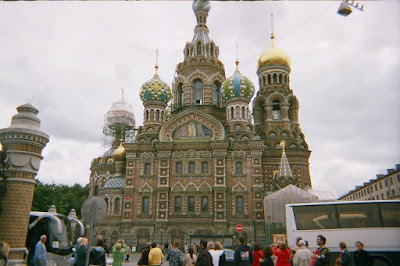
Why Isaac? Well it turns out that Peter I was born on the feast day of Isaac the Dalmatian (aka, Isaac the confessor) who was a 4th century monk. Peter I had asked not to be named in a church so this was an indirect way of honoring him (and he never said not to name a town square after him).
The fellow on the horse is Peter I.
Near there is the Church of Our Savior's spilled blood. In this case, the savior is Alexander II who was assassinated at this point (it is on a canal). This was built between about 1885 and 1908 but is done in the style of the 16th century).
.
Thursday, August 20, 2009
Hermitage, Winter Palace and Vicinity
On the land side, the Hermitage is seen across Palace Square. In the square there is a 220' column made of red granite and topped with a statue of Alexander I (victory over Napoleon being the theme).
 The Hermitage (a museum with about 3 million art objects) is made of several buildings. The Winter Palace of the Czars is the main building but several mansions belonging to high nobility (that abutted the Winter Palace) are also part of the Hermitage
The Hermitage (a museum with about 3 million art objects) is made of several buildings. The Winter Palace of the Czars is the main building but several mansions belonging to high nobility (that abutted the Winter Palace) are also part of the Hermitage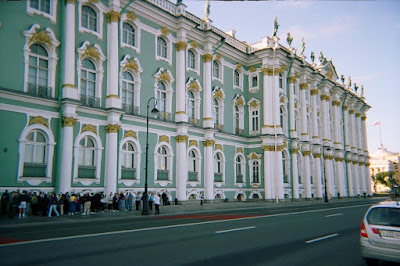 Near the palace on the Neva River is a model of the first Russian ship "Aurora" (there is a second Aurora which is an ironclad). The first one sailed during the middle of the 19th century.
Near the palace on the Neva River is a model of the first Russian ship "Aurora" (there is a second Aurora which is an ironclad). The first one sailed during the middle of the 19th century.The Neva River side of the Winter Palace looks different. It has statues on the front of the building and the window frames have gilding.




Within the winter palace itself is the throne room. The two faced eagle is supposed to symbolize that Russia looks both east and west but obviously when Peter I built the capital here, Russia mostly looked west (which is why the architecture and art are almost all European)
In the glass box is a clock decorated with a golden peacock.
It seems that peacocks were something of symbol of wealth dating from Roman times and the Czars were nothing if not wealthy. That's our tour guide holding the '28' sign.
Like the summer palace, the winter palace has the rooms all lined up. However, in the winter palace they use arches between room. This creates a golden tunnel effect different than in the summer palace because the ceilings are visible (and decorated). The hall goes through about a dozen rooms, each about 30' wide and so it makes for about a golden tunnel that is more than the length of a football field. We were the 1st tour group in the Hermitage that day so it is relatively light on people but by the time we left it was very, very crowded.
The last image is that of the gold ball room. Everything is gold plated or gilded (mostly gilded). The chandelier is made from the paper mache reinforced by many coats of lacquor.
By the way, this egregious wealth was accumulated in a land of extreme poverty. In addition, St Petersburg itself was built with a lot of slave labor and conscript labor and POW labor (Peter's battles in the Northern War against Sweden resulted in many Swedes being captured and worked to death building St. Petersburg. In all, about 40,000 people are thought to have died building the town and it is sometimes called, the City built on bones.
Finally, a funny story. During our tour, one of our group went very close to one of the huge malachite vases they have in the place and a 'guard' gave her a tongue lashing (in Russian). The tourist went to our tour guide who said, "Don't pay attention to this man, he is a big boss of a small space. We have many like this. It is gift [she probably meant 'legacy'] of Soviet period of our history."
I think this means that some well connected people have been given too-well paid guard jobs at the museum and they are resented by tour guides who consider their pay more 'earned'.
.
Friday, August 21, 2009

 Tallinn
TallinnA lot of cities have an 'old town' (for example Stockholm). Tallinn has two old towns. There is an upper old town, where the nobility lived and a lower old town where the ordinary mercantile class lived (some merchants became nobles). The houses on this street are about 400 years old (they have modern stuff retrofitted), however, they are built on the remains of houses that were 100-200 years older than that. This street is on the upper old town. In the background is St Olaf's Cathedral (more on this below).

The building in pink is the legislature building. It looks like much of the northern European imperial and state buildings however what is different about it is that it directly abuts a fortress (the tower of which is still standing; the fortress is about 500 years old).


 The amphitheater is where the annual Estonian song festival takes place. They also have an every five year festival with enhanced song making (I think audience singing is part of it) This doesn't sound like much and it doesn't look like much when it is empty. However, at the previous 5-year festival 300,000 of the country's 1,500,000 population showed up (Tallinn itself has about 400,000 so maybe this sounds more impressive than it is). Madonna drew an audience of 60,000 by comparison.
The amphitheater is where the annual Estonian song festival takes place. They also have an every five year festival with enhanced song making (I think audience singing is part of it) This doesn't sound like much and it doesn't look like much when it is empty. However, at the previous 5-year festival 300,000 of the country's 1,500,000 population showed up (Tallinn itself has about 400,000 so maybe this sounds more impressive than it is). Madonna drew an audience of 60,000 by comparison.The next three images are from the internet.
The ornate church is the Alexander Nevsky Church (Russian Orthodox) built about 1900 on a 'revivalist' theme capturing both the onion domes of old Russia and the more modern (at the time) use of heavy window ornamentation and vertical sight lines.
During the 1918-1934 period of Independence, it was almost torn down (because the people hated Russia so much) but since independence in 1991, the govt has restored it, even though most of the population is anti religion (70% of the population said 'none' when the previous census asked them to identify a religion) and the eastern orthodox are only 5-10% of the population.
The statue is Russalka. It was built in 1902 as a monument to a steel armoured ship Russalka (similar design of the American civil war ship Monitor), which sailed from Tallinn to Helsinki in 1893 and sank in the Gulf of Finland. In Slavic legend, a Russalka is a type of female mermaid ghost.
The image with all the towers on it shows their proliferation. The large one in the foreground belongs to the town hall. The tall one in the background is St Olaf's Cathedral was built in the 12th century, then expanded in the 13th and rebuilt in the 14th century and 15th century. After a rebuilding in about 1500, it was about 500' tall and, as late as about 1650, it was the world's tallest structure. Subsequently it has been rebuilt after being hit by lightening and now is only about 420' tall but still visible many miles out from the harbor.
Funny story - our tour guide said that during the soviet rule there was only soviet approved media. The most popular shows were two soap operas (he called them 'soap serials') from Russia. Within 6 months of independence, they were broadcasting their own, Estonian language soap opera. Funny part: they are very proud of this accomplishment.
Estonia's language is similar to that of Finland and Hungary. Since independence, Finlanders have invested heavily in Estonia. Our tour guide was also proud of the fact that Skype telephone service was invented in Estonia and that a lot of ships are built in Estonia.
Sunday, August 23, 2009
 Copenhagen
CopenhagenFirst image is Ann in front of the harbor. That's not our ship in the background. Ours was bigger.
This is the only image I actually took, the others are from the internet.




 The next image is the Round Tower or in Danish, Rundetårn. It was built about 1640 by order of King Christian IV, and used as an observatory almost immediately, by for example, Tycho Branche. It is the oldest permanent observatory in Europe. Among the embossed lettering on the front is God's 4 letter hebrew name with a defect in the vov (the letter pronounced as a 'v').
The next image is the Round Tower or in Danish, Rundetårn. It was built about 1640 by order of King Christian IV, and used as an observatory almost immediately, by for example, Tycho Branche. It is the oldest permanent observatory in Europe. Among the embossed lettering on the front is God's 4 letter hebrew name with a defect in the vov (the letter pronounced as a 'v'). The strange looking black glass and granite building is called the black diamond or Den Sorte Diamant (in Danish). It houses the royal library. It's lean resembles a building you see on the way to and from Dulles International Airport.
The image of the little mermaid is just that. This statue is famous (unjustly so in my opinion) because the mermaid story is so sweet and sad. It seems the mermaid traded her fishtail for the ability to talk because she wanted to speak to her lover but then drowned because without the fishtail she couldn't swim. The statue was completed in 1913. A ballet dancer was the model for the face, the sculptor's wife was the model for the rest.
We also went near a statue of Soren Kierkegaard. He is the Danish philosopher who represents the apex of the existentialist philosophy (if, because there is no God, what we do doesn't matter, then all that matters is what we do).
The more interesting statue is the Gefion fountain (in Danish, Gefionspringvandet). It was built in the early 1900s. A norse goddess, Gefjun plowed all of Copenhagen in one day thus winning sovereignty for the island. It was dedicated by the Carlson brewery.

In the middle of the oldest part of Copenhagen on the island Slotsholmen, is Christiansborg Castle. It is the site of the Danish parliament, Folketinget. The current building dates from about 1920 and is the third building on this site (the others having burned). The first castle on the site dates from about 1200. Once it was the site of Danish Royal Family residence but they now reside at another castle.
.
.
.
..


The Amsterdam Museums
We went to a bunch of Museums in Amsterdam.
The first image is from the internet and is of the State Museum. Mine is below and not as good.
The image of the ship was taken in the Amsterdam Historical Museum. The ship is about a 1 to 150 scale model of a 17th century cargo ship. This is the kind of ship that made Holland wealthy.
The next image is of 4 wooden statues that were used in the 14th century to show the characteristics of the court of civil Amsterdam (justice, mercy, social good and honor - or something like that)

The most interesting thing I learned about Holland was the progressiveness along side the not so progressive. While Holland was becoming rich from suger trade (which required lots of slaves) and also engaging in the slave trade (which although a money maker was 'just' a subsidiary business of the sugar trade), they were progressive enough to begin incarceration as an alternative to corporeal punishment, fund orphanages (the historical museum is in a building once used as an orphanage) and mental hospitals.
At the State Museum (Rijksmuseum Amsterdam), we ran into a couple who were at our dining room table). This is the outside. Images were hard to take on the inside but there were lots of Rembrandt pictures and lots of historical material. Most everything is from the 17th century, a.k.a., the Golden Age of Amsterdam. The museum dates from about 1800, the building from about 1860.

The next image is the outside (not facing the street) of the Van Gogh Museum. They organized the museum by the career of Van Gogh (and they had some other paintings). We got some t shirts with "starry night" from a street vendor near the museum.
The boat is part of the Naval Museum. The boat is a recreation of the ship "Amsterdam" which was destroyed in 1749 in the English Channel.

 .
..
.
.
..
Wednesday, August 25, 2009


 Wednesday August 25
Wednesday August 25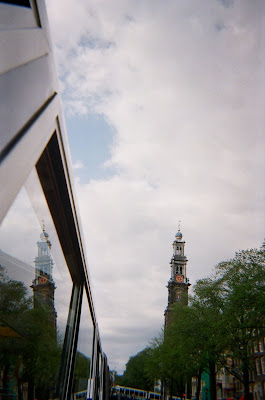 Amsterdam Via Canal
Amsterdam Via CanalWe got two "I Amsterdam" cards (about $70 each) which entitled us to see about a dozen museums and also to get a canal ride.
We met the Irish ladies from our supper table along the canal on our way to getting the ride.
The canal boat is very low since the bridges are low (as can be seen in the image of the bridge - yes we went under this one). Notwithstanding the low bridges, a lot of merchandise gets to people in Amsterdam at least partially by boat.
The building seen in the image is the back of the Ann Frank Museum. It is on a canal.
In one of my forward canal shots, you see us passing another canal boat nearly identical to ours.
In the far background is the tower of the Westerkerk (that is the
Western Church)
I'm somewhat proud of the last image. I got two Westerkerks in the picture by using the reflection off the canal boat.
.
.
Wednesday, August 25, 2009



 Amsterdam -
Amsterdam -Last full day
The first image is one of my favorites.
It is a shopping mall constructed in about 1900 (one the the world's first such places probably) and was initially a retail establishment taking advantage of its location between the central transit station and the State Museum.
The second image is an image of Ann standing on the street near our hotel (its the one where the porch sticks out a bit on the same side of the street as Ann). The hotel was in a residential section.
We had a streetcar stop pretty near us (we bought two 48 hour transit passes for about $15 each).
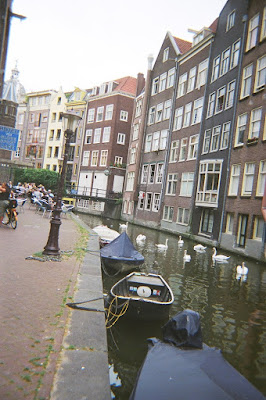

The first thing we saw on that day was the old Sephardic (sometimes called "the Portuguese") Synagogue. It was built early in the 1700s. The defect in the ceiling shown in the image was built into the design intentionally. It symbolizes the destruction of the Temple at the end of the 2nd Commonwealth.
The other image of the Synagogue shows detail of the interior. The chandeliers are bronze. For reasons still unknown, this synagogue was untouched by the Nazis during WW II (although they thoroughly looted the Ashkenaz synagogues a block away).
In the afternoon that day we visited the Red Light district (I didn't take any pictures of the gesturing ladies in the picture windows but they were they even at this hour). This image is at the north end of the district. There was a little tavern where the beer was relatively inexpensive and we could watch the swans.
 During our transit ventures we frequently had to change lines at the central station. The fancy building with a small clock is the central station.
During our transit ventures we frequently had to change lines at the central station. The fancy building with a small clock is the central station.The tower with the white stacked columns on top is was, at one time, a warehouse containing goods and owned by a wealthy partner in the East India Company.
August 27 Flying home.
We had some delays. The Airbus 330 had a malfunctioning oven so we waited in our seats for about 90 minutes and ended up getting home late (also a late baggage service and the limo had trouble finding the address before ours) but otherwise a good trip.
.
.
.
.
